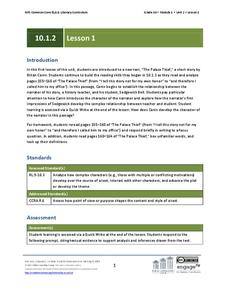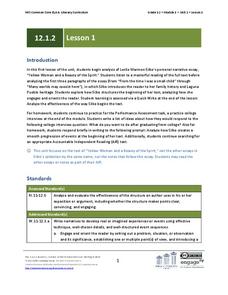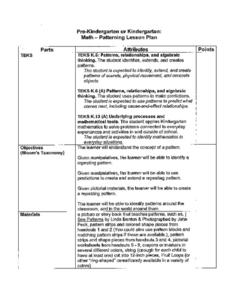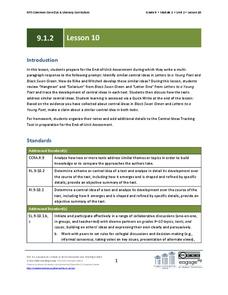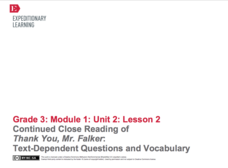EngageNY
Grade 10 ELA Module 1: Unit 2, Lesson 11
Is identity unchanging? Do events in our childhood forever influence our character? Groups ponder these questions as they examine Ethan Canin’s short story “The Palace Thief.”
EngageNY
Grade 10 ELA Module 1: Unit 2, Lesson 4
Can a life gone wrong be blamed on a single childhood incident? Hundert, the narrator of "The Palace Thief," and readers struggle with this question as they ponder events in Ethan Canin's story.
EngageNY
Grade 10 ELA Module 1: Unit 2, Lesson 1
The complex relationship between a teacher and his student takes center stage in an instructional activity that asks readers to pay close attention to how author Ethan Canin introduces his characters and how he develops the character of...
Germantown School District
Close Reading World Religions: Islam
As part of a close reading activity, individuals respond to three questions and craft two short essays based on a passage about Islam, one of the world most widespread religion.
TLS Books
Dictionary Skills Review
Why do we use a dictionary? Your scholars will tell you why while demonstrating their dictionary skills. In addition to stating the purpose of using dictionaries, they will also show what they know about guide words, alphabetizing,...
EngageNY
Grade 9 ELA Module 1, Unit 1, Lesson 3
Just like in real life, characters in short stories show their true personalities through their words and deeds. Decipher the character development in Karen Russell's "St. Lucy's Home for Girls Raised by Wolves" with a set of activities...
EngageNY
Grade 9 ELA Module 1, Unit 2, Lesson 7
Readers analyze David Mitchell's techniques for introducing and developing the mystery surrounding Madame Crommelynck in the "Solarium" chapter of his novel Black Swan Green.
EngageNY
Grade 12 ELA Module 1, Unit 2, Lesson 1
As part of a study of narrative writing, class members analyze how Leslie Marmon Silko structures the beginning and orients and engages readers in her narrative, "Yellow Woman and a Beauty of the Spirit."
EngageNY
Grade 12 ELA Module 1, Unit 3, Lesson 2
Where to begin? This lesson plan, part of a series designed to help seniors compose a narrative response to a prompt found on the college Common Application, focuses on the techniques writers employ to craft an engaging introduction to...
EngageNY
Grade 9 ELA Module 1, Unit 2, Lesson 3
How do writers develop a central idea in a text? How can readers identify this central idea? These are the challenges class members tackle as they continue their analysis of "Letter One" from Rainer Maria Rilke's Letters to a Young Poet.
EngageNY
Grade 12 ELA Module 1, Unit 2, Lesson 5
As class members conclude their reading of Leslie Marmon Silko's "Yellow Woman and a Beauty of the Spirit," they consider how the story of Kochininako, Yellow Woman, not only provides a satisfying ending to the narrative but also...
Curated OER
Patterning Lesson Plan
Open the eyes of young mathematicians to the patterns that are found everywhere in the world around them. After a shared reading of I See Patterns by Linda Benton, children complete a series of hands-on activities that teach them...
EngageNY
Grade 9 ELA Module 1, Unit 2, Lesson 10
To prepare for the end-of-unit multi-paragraph essay, class members review Rainer Maria Rilke's collection, Letters to a Young Poet, and David Mitchell's Black Swan Green and identify central ideas in both texts. Writers then formulate a...
EngageNY
Grade 12 ELA Module 1, Unit 2, Lesson 2
As part of their reading of Leslie Marmon Silko's "Yellow Woman and a Beauty of the Spirit," class members analyze how the author develops her narrative through dialogue, description, and multiple plot lines.
Curated OER
Reading Meet Writing
Thinking about introducing your middle schoolers to reading log journals? Try the approach suggested by this resource. After reading to the class an article or portion of a novel, demonstrate a Think Aloud and then model how to transform...
Learning Links
The Josefina Story Quilt Study Guide
Considering using The Josefina Story Quilt in your classroom? Check out this sample teaching guide for a list of pre-reading activities.
Curated OER
Reading With Fluency And Expression
Practice makes perfect, and this lesson provides a rubric to prove it! To improve their ability to read with fluency and expression, readers listen to a series of online stories in order to hear how a well-read story should sound. They...
Curated OER
Shizuko’s Daughter: Before, During, After Lesson Plan
Shizuko's Daughter by Kyoko Mori presents a vivid picture of Japanese culture and history. As kids read through the third chapter, they find novel-specific vocabulary to enhance their understanding and use context clues to...
Curated OER
Elementary Reading: Five Passages with Questions
Five brief readings with questions support practice with various literacy skills. In some cases, learners identify whether underlined words are spelled correctly. Other times, they answer reading comprehension questions about the text or...
Curated OER
Make a Social Skills Superhero Comic Book
Get creative as you teach a lesson on positive peer and social interactions. Discuss good social interactions through a scenario, brainstorm a positive response to the scenario, then creat a comic book superhero that exemplifies the...
Mary Pope Osborne, Classroom Adventures Program
Dinosaurs Before Dark
Young readers travel back to the time of the dinosaurs in this literature unit based on the story Dinosaurs Before Dark. Intended for use with upper-elementary special education young scholars, this resource provides reading...
ReadWriteThink
Literature Circles: Getting Started
Make reading more enjoyable and interactive with literature circles! Here you'll find detailed lessons to begin the literature circle process. Ten lessons introduce each role learners take on. Literature circle roles include...
EngageNY
Close Reading of Thank You, Mr. Falker: Identifying the Superpowers of Reading
Third graders read excepts from the story, Thank You, Mr. Falker in order to gain practice in understanding an unfamiliar story by focusing on the details. They use a worksheet, embedded in the plan, which directs them to certain...
EngageNY
Continued Close Reading of Thank You, Mr. Falker: Text Dependent Questions and Vocabulary
In the second lesson plan in a series that revolves around the story, Thank You, Mr. Falker, learners practice the skill of answering direct questions from the text while using complete sentences. After a teacher-led review of how to...




